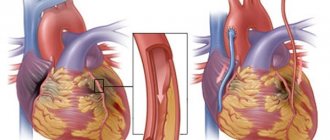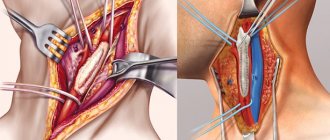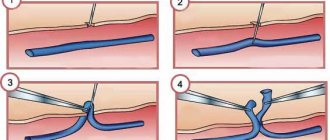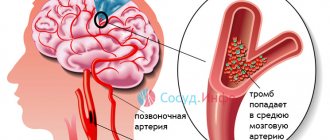Vascular diseases occur in both women and men. More often, pathologies affect middle-aged and elderly people. Vascular diseases are less common in young people. In some cases, such pathologies are congenital. Typical localizations of damage to the vascular system are the coronary, cerebral arteries, veins of the rectum and lower extremities. However, with systemic vasculitis, the process can be widespread throughout the body. One of the common reasons for visiting a surgeon is varicose veins. This pathology occurs more often in women. Characteristic symptoms are: tortuosity of the veins, their expansion, protrusion. Another vascular disease is atherosclerosis. It leads to blockage of arteries and disruption of blood flow. In advanced cases with both pathologies, bypass surgery of the vessels of the lower extremities is performed. This is a surgical operation, thanks to which blood flow can be completely restored.
What is the purpose of bypassing the blood vessels of the legs?
A necessary measure for diseases of the veins and arteries is bypass surgery of the vessels of the lower extremities. Treatment in the initial stages is carried out conservatively. Patients suffering from atherosclerotic lesions are prescribed lipid-lowering drugs (medicines Atorvastatin, Fenofibrate) and diet. For varicose veins, it is recommended to wear special elastic underwear and sclerotherapy. Bypass surgery of the vessels of the lower extremities is performed in cases of severe blockage of the lumen of an artery or vein, a high risk of thrombus formation and the development of gangrene. This procedure is a surgical intervention and must be performed by an angiosurgeon. Bypass surgery is the replacement of a section of a vessel with an implant. As a result, blood supply is restored and the risk of blood clots is significantly reduced. The shunt can be made from artificial materials or the patient's own tissue. Often adjacent vessels of the lower extremities are used as an implant. The choice of material depends on the diameter of the damaged artery or vein, as well as on the characteristics of the pathology.
Indications for bypass surgery of lower extremity vessels
The operation to bypass the vessels of the lower extremities is performed in a specialized or surgical department of the hospital. It is a complex procedure and should therefore only be performed according to strict indications. Vascular bypass should be resorted to if more than 50% of the diameter of an artery or vein is obstructed. Before deciding on surgery, doctors prescribe conservative treatment. Surgery is performed if there is no effect from the therapy. The following indications for bypass surgery of the vessels of the lower extremities are distinguished:
- Obliterating atherosclerosis of the arteries.
- Severe pathologies of the venous system. More often, for varicose veins and threats of thrombophlebitis, stenting or angioplasty is performed. If such treatment methods are contraindicated, vascular bypass surgery is performed.
- Endarteritis. With this pathology, the inflammatory reaction is combined with progressive obliteration of small vessels. Gradually, the arteries become completely blocked, leading to gangrene of the foot. This disease is more common among the male population.
- Aneurysm of the arteries of the lower extremities. The pathology is dangerous with a high risk of bleeding, which is extremely difficult to stop.
In some cases, bypass surgery of the vessels of the lower extremities is performed for gangrene of the toes or feet. The prognosis for this surgical intervention is not always favorable and depends on the area of necrosis and the individual characteristics of the body. In some cases, surgery leads to healing of gangrene or reduction in the size of the affected lesion.
Diagnostics
To identify the full picture of the disease, the patient undergoes several studies. First, the specialist questions him about the location of the pain and other symptoms, performs an examination and examines the pulse. Next, using the following diagnostic methods, the location of atherosclerotic plaques is determined:
- MRI – evaluates disturbances in blood flow and changes in blood vessels.
- CT scan – determines the severity of changes caused by atherosclerosis.
- Duplex ultrasound – evaluates changes in blood flow and abnormalities in blood vessels in real time.
Based on the research results, the doctor determines the appropriate method for solving the problem . Treatment can be done with medications, endovascular angioplasty, stenting, or bypass surgery.
In what situations is bypass surgery contraindicated?
Despite the effectiveness of vascular bypass, it is worth remembering that such an operation is very serious. Therefore, it is performed only in cases where other treatment methods do not help. There are a number of contraindications to bypass surgery. Among them:
- Hypertension not controlled by antihypertensive drugs. In this case, vascular surgery can lead to cardiogenic shock, myocardial infarction or stroke.
- Decompensated heart failure, accompanied by edema syndrome and constant shortness of breath.
- Unstable angina.
- Acute heart failure and myocardial infarction.
- Aneurysm of the aorta, cerebral vessels.
- Paroxysmal heart rhythm disturbances.
Bypass surgery of the vessels of the lower extremities cannot be performed in case of infectious diseases, skin lesions, or decompensation of diabetes mellitus. In these cases, the operation is performed after stabilization of the patient's condition.
Contraindications
Vascular bypass surgery is a serious surgical procedure. It may be contraindicated in patients at high risk of cardiovascular complications:
- high blood pressure that is difficult to treat;
- severe heart failure with shortness of breath and edema at rest;
- frequent attacks of angina pectoris;
- cardiac aneurysm;
- severe heart rhythm disturbances - atrial fibrillation, ventricular tachycardia and others.
Surgery may be postponed in case of high blood sugar levels and severe diabetes, infectious diseases and lesions of the skin of the legs.
Bypass techniques
The most common procedure is arterial bypass surgery. This is due to the fact that such pathologies are more common. In addition, other treatment methods are recommended for vein involvement. These include balloon angioplasty and stenting. The saphenous vein of the thigh is used as shunts to restore arterial blood flow. If the affected area is large or the condition of the blood vessels is unsatisfactory, synthetic implants are used. There are several methods of performing the operation. Among them:
- Aortobifemoral bypass surgery. Surgical intervention is performed at the level of the groin area. The essence of the operation is to create a bypass anastomosis between the abdominal aorta and the femoral arteries.
- Femoropopliteal bypass surgery. An anastomosis is formed between two large arteries of the lower limb. The shunt originates at the base of the thigh and is brought to the knee joint area (below or above the joint).
- Cross shunting. The anastomosis runs between the two femoral arteries (from the right leg to the left lower limb, or vice versa).
- Femorotibial shunting. The vascular graft connects the femoral and tibial arteries.
Complications
the following complications may arise during its implementation :
- Negative reaction to anesthesia.
- The occurrence of bleeding.
- Blockage of the bypass area by blood clots or blood clots.
- Infection.
- The need for limb amputation.
- Death, heart attack.
In the category of people with a high probability of such complications occurring are patients who have the following problems :
- High blood pressure.
- Excess weight.
- High cholesterol content.
- Low physical activity.
- Chronic obstructive pulmonary pathologies.
- Diabetes
- Kidney failure.
- Coronary disease.
- Smoking.
Preparing the patient for vascular bypass surgery
Preparation for bypass surgery includes a number of diagnostic procedures, as well as the use of medications. Before the operation, it is necessary to undergo a laboratory examination: OBC, OAM, biochemical blood test, coagulogram. Dopplerography of the vessels of the lower extremities, ECG, and echocardiography are also performed. To avoid blood clots during surgery, blood thinners are prescribed a week before surgery. These include medications “Aspirin Cardio”, “Magnicor”. Antibiotics and anti-inflammatory drugs are also prescribed. In the evening, on the eve of the operation, you must stop taking water and food.
Preoperative assessment
The doctor questions the patient in detail about complaints, the time of their onset, and concomitant diseases. He conducts a thorough examination of the legs, determines skin temperature, skin color, pulsation of peripheral arteries, identifies sensory disturbances and other objective signs of the disease.
Additionally, the following diagnostic tests are used:
determination of pressure and pulsation in the groin, popliteal areas and above the ankles to preliminary determine the location of the blockage;- Dopplerography of a vessel - ultrasound examination of blood flow speed, which allows you to accurately determine the location of the lesion;
- angiography is an x-ray method that allows all arterial vessels of the limb to be recorded on an x-ray;
- Spiral computed tomography or magnetic resonance angiography are modern, safer and more accurate methods compared to standard angiography.
A blood test is performed to determine cholesterol levels, blood sugar and other indicators. Doctors also look for signs of inflammation, which may be causing the arteries to narrow.
Technique for bypass surgery of lower extremity vessels
Bypass surgery of the vessels of the lower extremities is a complex operation that requires high professionalism of the surgeon. The manipulation is performed under general anesthesia. An incision in the skin and underlying tissue is made in 2 places – above and below the affected area of the artery. Clamps are placed on the vessel to prevent bleeding. After assessing the affected area, an incision is made on the vessel and the shunt is fixed on one side. Next, the vascular flap is secured between the muscles and tendons. Thus, the shunt is gradually brought to the site of the second incision (above the lesion) and its end is fixed. After this, the surgeon assesses the state of the blood flow. When the operation is successful, the artery begins to pulsate. In some cases, instrumental examination methods are performed. The final stage of surgery is suturing the deep tissues and skin.
Surgery
Bypass surgery of the blood vessels of the legs is a complex operation that requires high professionalism and certain experience from the surgeon. The operation is performed under general or local anesthesia, depending on medical indications and the general condition of the patients. Epidural anesthesia is considered a modern priority method of pain relief, significantly reducing surgical risk.
Bypass surgery is performed when the patency of arterial and venous trunks is impaired, if their obstruction is more than 50% of the diameter. During the operation, a bypass path is created using a graft from the beginning of the obstacle to its end. Correctly performed surgery ensures restoration of blood flow in the affected vessels.
How does the postoperative period proceed?
Inpatient monitoring of a patient who has undergone surgery is very important. Especially if this manipulation is bypass surgery of the vessels of the lower extremities. The postoperative period for successful treatment is about 2 weeks. On days 7-10, the surgeon removes the sutures. While the patient is in the hospital, diagnostic procedures must be performed to assess the effectiveness of treatment. In addition, the doctor must make sure that there are no postoperative complications. It is recommended to get back on your feet in the first days after surgery. In sitting and lying positions, the lower limbs must be fixed in an elevated state.
Recovery after surgery
The operation lasts 1-3 hours . After its completion, sometimes you have to put on an oxygen mask, and within 1-2 days an anesthetic is administered using a dropper. During epidural anesthesia, the needle is not removed for 3-5 days. to reduce pain. After its removal, painkillers are immediately given. The following are used as rehabilitation measures in a medical institution:
- For 1-2 days, to reduce swelling and pain, apply cold compresses for 15-20 minutes.
- Wearing special socks and boots to prevent blood clots.
- Using an incentive spirometer to improve lung function.
- Check your incisions regularly to monitor for signs of infection.
After discharge from the hospital, the following measures are taken to ensure a successful recovery:
- Working with a physiotherapist.
- Walking independently, increasing the distance daily, will make your legs stronger.
- When sleeping and sitting, keep your limbs elevated.
- Keep postoperative wounds dry without using powder or powder.
- Do not eat fatty foods and do not smoke.
- Follow the doctor's instructions and return to everyday life.
Recommendations during the recovery period
After bypass surgery of the vessels of the lower extremities, it is necessary to monitor the state of blood flow. For this purpose, the patient must undergo periodic examinations (ultrasound and Doppler ultrasound). Also recommended:
- Stop smoking.
- Take antiplatelet drugs to prevent thrombosis.
- Monitor your body weight. If BMI increases, a lipid-lowering diet and drug treatment are prescribed.
- Take daily walks.
- Wear special stockings (socks) and shoes.
Lower extremity vascular bypass surgery: patient reviews
Reviews from patients who have undergone surgery are mostly positive. Patients note a decrease in pain and numbness in the legs. However, in some cases, people complain that symptoms return after a while. This is due to damage to neighboring arteries and veins. It is worth remembering that bypass surgery is not a treatment for atherosclerosis, and the cause of vascular damage does not disappear after surgery. Therefore, to avoid thrombosis and the development of gangrene, it is important to follow preventive measures.










